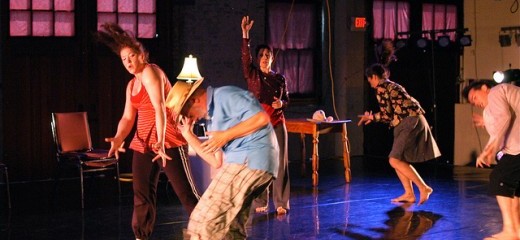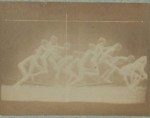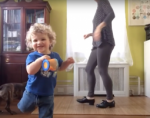
Photo: Andrew Simonet
Episodes and Academe: Avalanche
Lynn Matluck Brooks
How do dance profs—admittedly odd birds in academe—engage in research? Lots of ways, one being the explorative process that was guided by Headlong Dance Theater’s artistic staff at Bates and Colby Colleges this past year. That process resulted in
Avalanche, which had its Philadelphia premiere at the Performance Garage on June 14.
College-level dance and theater teachers have long made the case for performance as a mode of investigation, a way of knowing, that is as valid as archival or experimental research-and-publication (the more familiar path universities recognize toward tenure and promotion). We who teach performing arts in such institutions often justify our presence in the academy by arguing that our students, our audiences, and we ourselves find these modes of learning and of expression enlightening, critical, engaging, essential to truth-seeking and self-knowing. Some schools buy the argument, even embrace it. Clearly, Colby and Bates are leaders of this pack. Funded by an Andrew W. Mellon grant, five professors of dance and theater engaged in a nine-month process of exploration, improvisation, and choreography to which they contributed words, memories, movements, material, arguments, opinions, provocations, and trust. Headlong’s staff—Amy Smith, David Brick, Andrew Simonet, and Mark Lord—offered prompts, feedback, questions, and direction. A work took shape—ever-changing shape—with large chunks of improvisation remaining: some material that, the performers told us in a post-show talk-back, looked set but wasn’t or was set but looked spontaneous. I’m glad I stayed to learn that. The piece was, in many ways, curious.
At the opening of the piece, the stage looked like a furniture warehouse: a couch, some chairs, a blackboard, stools, a couple of lamps, some blankets and sheets, an old hat or two were stashed more or less upstage in a jumble. The dancers variously moved these odds and ends around the stage, sometimes allowing them to frame a section of dance, sometimes placing them as roadblocks or obstacles, other times organizing them as familiar rooms or circus sets. At moments in the dance, the piled-up furniture tumbled precariously around the performers: avalanche? Longer and shorter bits of spoken texts accompanied sections of the dance, coherent or not, to varying degrees: memories tumbling forth like dreams. The performers threw themselves into races, dance phrases, games, supports and falls, only to catch themselves in moments of repose: roiling episodes that started, proceeded, and came to perceptible closure before the next installment began.
The dancers were a ball to watch, each a distinctive mover, from the well-oiled looping phrases of Carol Dilley (Bates College) crossing the stage to the deliciously awkward procession of Michael Reidy (Bates) around its edges. With an earnestly intoned litany of instructions and anguish stemming from her memories of a dance competition, Rachel Boggia (Bates) drew guffaws from the audience—many dance academics themselves, attending the show as part of the Society of Dance History Scholars conference that had opened earlier in the day at the University of the Arts. Annie Kloppenberg (Colby College) was a fierce yet coy force of energy, contained or unleashed; Todd Coulter (Colby) distinctly enunciated his audition memories before whirling wildly under a blanket: anguish to ecstasy.
In responding to the audience’s questions, following the 45-minute performance, the five performers were articulate—no wonder! Noteworthy to me was their attention to the ongoing evaluation they experienced of themselves, of one another, and of the creative process; the comparisons they made with more typical academic work; and their own roles as evaluators of students and student work, which made the vulnerability of Headlong’s process with them particularly daring. Yet, both the program notes and the conversation at the talk-back stressed that all participants were conscious, from the start, that process was leading to product, to the performance goal of Avalanche.
Ultimately, I valued the values that this work allowed the artists to express more than I did the work itself, with its episodic, highly personal, and internally driven logic that I didn’t always fully perceive. As an academic, a researcher and a teacher, I’m okay with that. I liked having an academic dance conference headed up by an investigative dance work. Then, we were primed to tumble into our papers, our history, our theory—all of that more typical academic work of dance history that is the raison de’etre of the Society of Dance History Scholars. After all, haven’t dancers always been vulnerable? It is just such lives and work that we seek to keep fresh in our historical research.
Avalanche was performed at the Performance Garage Thursday, Friday, and Saturday, June 14, 15, and 16, 2012.
By Lynn Matluck Brooks
June 18, 2012







.png)


